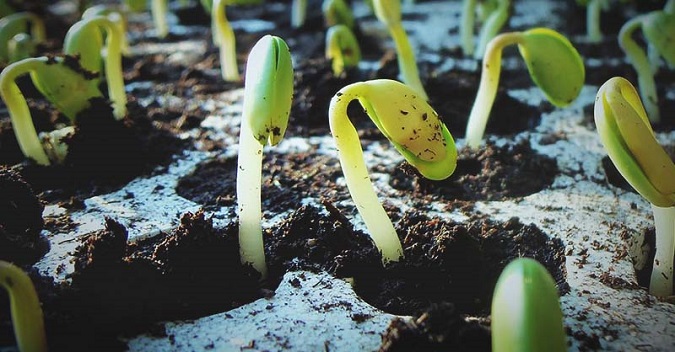
To help with germination, we hang fluorescent lights above the seed trays when we are starting vegetables from seed inside a building. Some plants, like lettuce, need light for germination. As the vegetable seedlings emerge, we keep an eye on them and transplant to larger containers as necessary to give them room to grow. You can use standard fluorescent light bulbs, or you can use the grow lights that are designed for raising seedlings. The grow lights cost considerably more but provide a better spectrum of light for the plants. The key is to have the lights right on top of the vegetable seedlings, so they receive the most intense light possible. If you don’t have sufficient light, the plants will get leggy and drop over.
The keys to starting vegetables from seed are moisture and warmth. The key to growing vegetable seedlings once they are started is light. If possible, put the seedlings outdoors or next to a window to catch the sun’s light without allowing them to get cold. Outside is best since having vegetable seedlings next to a window often just encourages them to lean over like they are trying to look up into the sun (which is exactly what they are trying to do). My preferred approach to starting vegetables from seed is to have the vegetable seeds in soil placed in a greenhouse or seedling house right from the start. With heater mats, a cold frame, seed tray domes, and thick blankets to cover things during the cold dark nights, the seeds will hardly know the difference.
The advantage of this approach is vegetable seedlings will receive the proper spectrum of light and the appropriate intensity of light right from the first moment they peek out to say “howdy”. They are also in just the right place for “hardening off” and if you have them in the greenhouse already, this is where they are going to live, so it is all the better in terms of convenience.
During the day, remove the insulation layer once the sun gets high enough to add heat to the plastic domes or seed house. With double plastic coverings, the seedlings can get to 130 degrees in full sun very quickly. Use your judgment as to when a layer of plastic needs to be removed to keep the seeds warm, but not hot. Wait until the plants are mature before you try cooking them. I have learned this through experience.
Starting vegetables from seed in seed trays means they will need to be transplanted into the garden. So, we need to work backwards from the expected transplant date to know when they should be started. Seed packets should give you information about when you should be starting vegetables from seed. Often, they will tell you to start seeds indoors so many weeks before last frost. For example, most tomato seeds take about 6-8 weeks to sprout and reach transplant size. So if your last frost date is May 31st, you would start your tomato seeds around April 7th. On May 31st, when you are ready to plant, you should have 8-week-old tomato plants ready to go.
Sometimes the seed packet advice is as simple as “direct sow as soon as the soil can be worked”.
In any case, you need to plan what and when you are going to plant. It’s helpful to record the date you plant the seeds, the date they germinated (and you could see the little seedling) and the date they were transplanted in the garden.
Our approach to starting vegetables from seed is to understand the time required for germination and growth of the vegetable seedlings so we can adjust the planting time to avoid the last frost dates associated with either our outdoor garden or one of the greenhouses. Since the greenhouses aren’t heated, we advance our plant dates only by about 2 weeks. The seeds are planted on dates that we believe will give us a reasonably good size plant just about the time we expect it will be safe to put it in the ground for production. Tomatoes need to be started early since they take a long time to grow and need warm weather to grow in. If you don’t start tomatoes, peppers and eggplant early, the harvest season in northern states will be short, and results will be pitiful. Check seed catalogs for specific recommendations for when you should be starting vegetables from seed in your area.
Not all vegetable seedlings are good for transplanting – some vegetables are better off if you direct seed them into warm soil in your garden. Carrots, radishes, beets, turnips and other root crops are best if they are direct seeded. Usually, they grow fast and don’t need to be started early. For example, radishes take only about 30 days to mature, sometimes less. The timing for lettuce is much the same.
We keep our seedlings watered and illuminated, waiting for the day when they can be transplanted. In the past, we constructed cold frames that allowed us to put the vegetable seedlings on the porch during the day to get sunlight, so they don’t get leggy. If you are starting vegetables from seed for planting into an open garden, a cold frame is almost a necessity. If you are going to use a greenhouse, then you can probably don’t need a cold frame and can just use the seed tray domes.
Clair Schwan is an experienced vegetable gardener with open sun gardening beds and three quality greenhouses of his own design and construction. He grows over 100 varieties of vegetables and provides fresh produce year-round for himself and his family.
Related Articles & Free Email Newsletter Sign Up
How to Germinate Seeds Indoors & Take Care of Seedlings
Hydroponic Propagation is an Easy Way to Start More Plants




Comment here